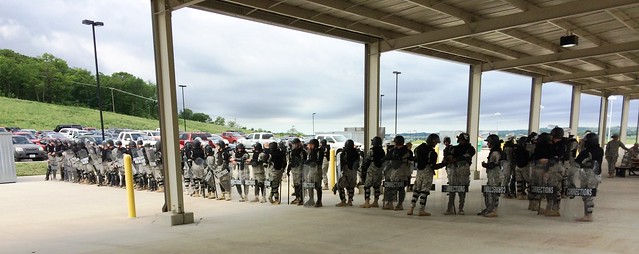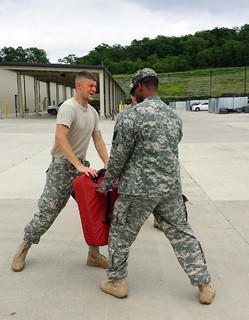Staff report
[caption id="" align="aligncenter" width="572"]

The Kentucky National Guard's 438th Military Police Company rehearses with the 165th Military Police Company on riot control tactics prior to entering Joint Regional Correctional Facility at Fort Leavenworth, Kansas, to curtail a staged inmate riot drill. (Photo courtesy Capt. Darren Kinman, 438th Military Police Company)
FORT LEAVENWORTH, Kansas -- The 438
th Military Police Company recently conducted its annual training mission at Fort Leavenworth, Kansas. The unit partnered with the 705
TH Military Police Battalion, which has the mission of running the Midwest Joint Regional Correctional Facility (JRCF). The 438
th is not the traditional combat support company, but a guard company.
According to Capt. Darren Kinman, one of the wartime functions for the 438
th is detainee operations, which include the processing of prisoners of war and running theater interment facilities.
[caption id="" align="alignleft" width="240"]

2nd Lt. Hallie Freeman conducts handcuffing procedures and arm bar take downs during a training exercise at Fort Leavenworth, Kansas. (Photo courtesy Capt. Darren Kinman, 438th Military Police Company)
“As a unit we needed to combine all the tasks running a facility with the stress of handling a confined individual,” he said. “When we deploy, they are truly at one arm’s length or closer to the enemy everyday working a cell block. That isn’t the time to find out if we are ready for this type of mission.
Rather than prisoners of war, the JRCF houses approximately 464 medium to minimum security inmates from all branches of service. The mission of the JRCF is to provide pre-trial confinement and post-trial incarceration for U.S. military prisoners sentenced to up to ten years.
“The day-to-day operations are very similar to the requirements needed to run a combat zone facility,” said Kinman. “We had been unable to completely replicate this environment in training, so we contacted the experts who do it every day. This allowed us to put all the pieces of training together and have someone to ask questions to refine our techniques, tactics and practices.”
[caption id="" align="alignright" width="248"]

Pvt. 1st Class Justin Morris stands tall as he completes his hand to hand level 1 OC (pepper spray) certification. (Photo courtesy Capt. Darren Kinman, 438th Military Police Company)
The 705
th sent a mobile training team to Murray to allow the unit to complete pre-certification required to work inside the facility. This included the standard operating procedures of the facility and how to deal with inmates. This also required a less then lethal certification course where soldiers had to experience the OC spray.
Upon arrival to Fort Leavenworth, the 438
th was integrated into the facility shadowing the soldiers in day-to-day operations. Also, the soldiers were able to conduct an emergency action drill where they were integrated into a massive exercise, from riot control to hostage negotiations, inside the facility from a staged inmate disturbance. The soldiers also conducted a facility wide shakedown in attempt to locate contraband possessed by the inmates.
The annual training mission has been beneficial in exposing the soldiers to shift work inside the facility. Meanwhile, it has allowed the unit to test its overall ability to conduct day-to-day operations in a real world environment.
"The soldiers get to feel the friction of controlling another human in confinement," said Kinman. "They've developed the confidence needed to handle a very serious mission if called upon."